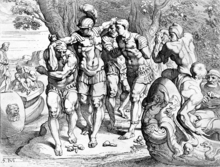
Scheria or Scherie, also known as Phaeacia or Faiakia, was a region in Greek mythology, first mentioned in Homer's Odyssey as the home of the Phaeacians and the last destination of Odysseus in his 10-year journey before returning home to Ithaca. It is one of the earliest descriptions of a utopia.

Ogygia is an island mentioned in Homer's Odyssey, Book V, as the home of the nymph Calypso, the daughter of the Titan Atlas. In Homer's Odyssey, Calypso detained Odysseus on Ogygia for seven years and kept him from returning to his home of Ithaca, wanting to marry him.
The Caucones were an autochthonous tribe of Anatolia, who later migrated to parts of the Greek mainland.
Opus was an ancient Greek city that was the chief city of a tribe of Locri, who were called from this place the Opuntian Locrians, and the territory, the Opuntian Locris.
The lotus tree is a plant that is referred to in stories from Greek and Roman mythology.
Cius, later renamed Prusias on the Sea after king Prusias I of Bithynia, was an ancient Greek city bordering the Propontis, in Bithynia and in Mysia, and had a long history, being mentioned by Herodotus, Xenophon, Aristotle, Strabo and Apollonius Rhodius.

The Echinades (; Greek: αἱ Ἐχινάδες νῆσοι per Herodotus, Thucydides, and Strabo, per Homer Echinae are a group of islands in the Ionian Sea, off the coast of Acarnania, Greece. The archipelago is commonly subdivided into three groups: the Drakoneres in the north, the Modia in the middle and the Ouniades in the south. Administratively, the Echinades form part of two regional units: Ithaca and Cephalonia. Six of the islands, including Oxeia, one of the largest, are owned by Sheikh Hamad bin Khalifa al-Thani, the emir of Qatar, who purchased them for a reported £7.3 million sterling. The Battle of the Echinades in 1427 and the Battle of Lepanto in 1571 were fought at or near the islands.
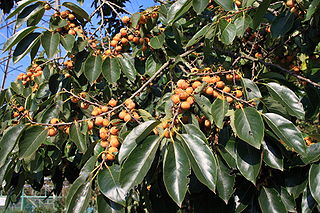
Diospyros lotus, with common names date-plum,Caucasian persimmon, or lilac persimmon, is a widely cultivated species of the genus Diospyros, native to temperate Asia and southeast Europe. Its English name derives from the small fruit, which have a taste reminiscent of both plums and dates. It is among the oldest plants in cultivation.
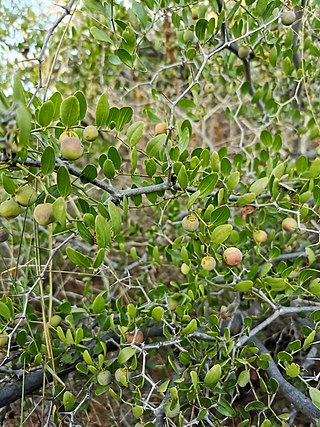
Ziziphus lotus is a small deciduous tree in the buckthorn family Rhamnaceae, native to the Mediterranean region, including the Sahara in Morocco and also Somalia. It is one of several species called "jujube", and is closely related to Z. jujuba, the true jujube.
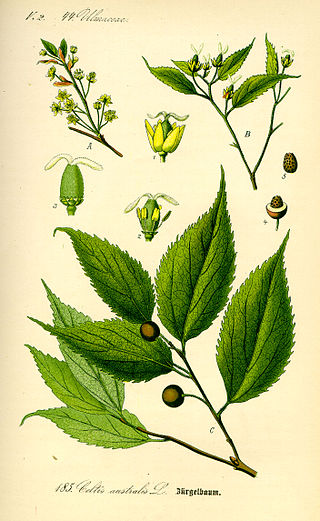
Celtis australis, the European nettle tree, Mediterranean hackberry, lote tree, or honeyberry, is a deciduous tree native to Southern Europe, North Africa, and Asia Minor. The tree was introduced to England in 1796.
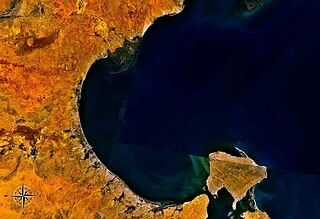
The Gulf of Gabes, also known as Lesser Syrtis, contrasting with the Greater Syrtis in Libya, is a gulf on Tunisia's east coast in the Mediterranean Sea, off North Africa. The gulf roughly spans the coast from Sfax to Djerba. At the head of the gulf is the city of Gabès (Ghannouche) where the tides have a large range of up to 2.1 m at spring tides. Both Gabès and Sfax are major ports on the gulf, supporting sponge and tuna fisheries, with Gabès being the economic and administrative center.
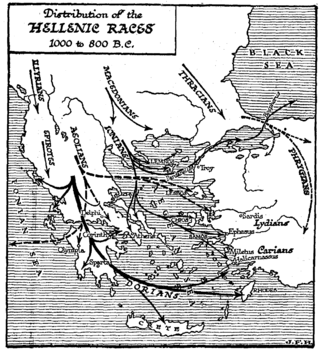
Doris is a small mountainous district in ancient Greece, bounded by Aetolia, southern Thessaly, the Ozolian Locris, and Phocis. It is the original homeland of the Dorian Greeks. It lies between Mounts Oeta and Parnassus, and consists of the valley of the river Pindus (Πίνδος), a tributary of the Cephissus, into which it flows not far from the sources of the latter. The Pindus is now called the Apostoliá. This valley is open towards Phocis; but it lies higher than the valley of the Cephissus, rising above the towns of Drymaea, Tithronium, and Amphicaea, which are the last towns in Phocis.

The Returns from Troy are the stories of how the Greek leaders returned after their victory in the Trojan War. Many Achaean heroes did not return to their homes, but died or founded colonies outside the Greek mainland. The most famous returns are those of Odysseus, whose wanderings are narrated in the Odyssey, and Agamemnon, whose murder at the hands of his wife Clytemnestra was portrayed in Greek tragedy.

During the Iron Age and Classical antiquity, Libya referred to modern-day Africa west of the Nile river. Greek and Roman geographers placed the dividing line between Libya/Africa and Asia at the Nile. In contrast, the areas of Sub-Saharan Africa were known as Aethiopia.

The locations mentioned in the narratives of Odysseus's adventures have long been debated. Events in the main sequence of the Odyssey take place in the Peloponnese and in what are now called the Ionian Islands. There are also incidental mentions of Troy and its house, Phoenicia, Egypt, and Crete, which hint at a geographical knowledge equal to, or perhaps slightly more extensive than that of the Iliad. The places visited by Odysseus in his journey have been variously identified with locations in Greece, Italy, Tunisia, the Maltese archipelago, and the Iberian peninsula. However, scholars both ancient and modern are divided whether any of the places visited by Odysseus were real. Many ancient writers came down squarely on the skeptical side; Strabo reported what the great geographer Eratosthenes had said in the late 3rd century BC: "You will find the scene of Odysseus' wanderings when you find the cobbler who sewed up the bag of winds."

Opuntian Locris or Eastern Locris was an ancient Greek region inhabited by the eastern division of the Locrians, the so-called tribe of the Locri Epicnemidii or Locri Opuntii.
The Troglodytae, or Troglodyti, were people mentioned in various locations by many ancient Greek and Roman geographers and historians, including Herodotus, Agatharchides, Diodorus Siculus, Strabo, Pliny, Josephus, Tacitus, Claudius Aelianus, Porphyry.

Moly ( MAW-lee) is a magical herb mentioned in book 10 of Homer's Odyssey.
Panopeus (Πανοπεύς), or Phanoteus, was a Greek town of ancient Phocis, near the frontier of Boeotia, and on the road from Daulis to Chaeronea. Pausanias said that Panopeus was 20 stadia from Chaeronea and 7 from Daulis; but the latter number is almost certainly a mistake. The ruins at the village of Agios Vlasios, which are clearly those of Panopeus, are about 20 stadia distant from Chaeronea, but as much as 27 stadia distant from Daulis.
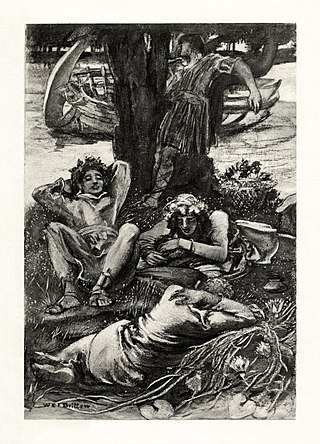
The Lotos-Eaters is a poem by Alfred Tennyson, 1st Baron Tennyson, published in Tennyson's 1832 poetry collection. It was inspired by his trip to Spain with his close friend Arthur Hallam, where they visited the Pyrenees mountains. The poem describes a group of mariners who, upon eating the lotos, are put into an altered state and isolated from the outside world. The title and concept derives from the lotus-eaters in Greek mythology.
